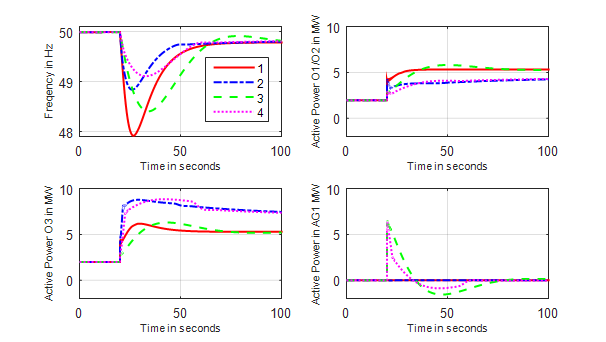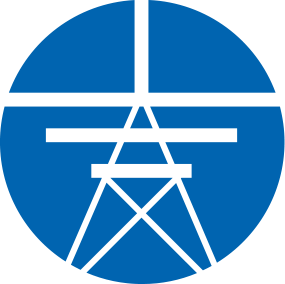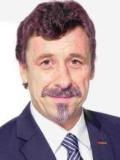Black Start and Grid Restoration
Events as the Italy blackout 2003 and the grid splitting 2006 triggered research and testing activity on the topic of black start ability and grid restoration leading to the ENTSO-E ‘Network Code on Emergency and Restoration’, which entered into force in 2017. Grid restoration strategies for the Austrian power grid concentrate on hydro power plants located in Salzburg and Carinthia, whereby several opportunities to black start an island are available and regularly examined in large scale black start and grid restoration tests. The Institute of Electrical Power Systems (IEAN) cooperates in these tests as scientific partner for the preparation and evaluation with Austrian grid and power plant operators.
The main work focus is to improve the frequency stability in the early stages of the grid restoration and to evaluate possible opportunities and challenges of a parallel grid restoration with several islands.
Frequency stability evaluations
The islands in the early stage of grid restoration have only a small number of connected generators resulting in high rate of change of frequency (ROCOF) values. It is therefore essential to investigate the possibilities in a given grid area, which help to avoid violation of frequency limits after a load reconnection. A general applicable operational action to improve the frequency stability is utilizing additional rotational energy by connecting further generators.
A more sophisticated solution is to increase the controller speed of the generator units in the islands forming the starting point of the grid restoration. The work of the institute focuses in this field on creating suitable controller models for the pre-evaluation of the estimated frequency nadir and for comparative studies of different generator and controller configurations. Exemplary for this work is the modelling of the controller of a Pelton unit with nozzle provision. The nozzle provision enables a fast increase of power by constantly diverting a part of the water jet away from the turbine.

Figure 1: Simulated frequency responses on positive 10 MW load step. The other graphs show the active power of the frequency controlling units O1-O3 and the additional generator AG1. O3 is equipped with nozzle provision for measurements 2 and 4, AG1 is inactive for measurements 1 and 2
Eine technisch anspruchsvollere Lösung besteht darin, die Reaktionsgeschwindigkeit der Frequenzregelung zu erhöhen. Die Arbeit des Instituts konzentriert sich in diesem Bereich auf die Erstellung geeigneter Reglermodelle für die simulationsunterstützte Untersuchung des Frequenzverlaufes und verschiedener Generator- und Reglerkonfigurationen. Beispielhaft für diese Arbeit ist die Modellierung der Düsenvorhaltung mit Strahlablenkerregelung einer Pelton-Einheit. Die Frequenzregelung der Peltonturbine mit dem Strahlablenker ermöglicht eine schnelle Leistungssteigerung, indem ein Teil des Wasserstrahls ständig von der Turbine weggeleitet wird.
Parallel Grid Restoration
The high number of power plants, mostly hydro plants, with confirmed black start ability located in the Austrian power grid at transmission grid and distribution grid level give the opportunity to adjust the grid restoration procedure to the actual circumstances leading to the black out. Consequently, the existing possibility with two parallel islands during grid restoration and their synchronization has to be practiced and evaluated.
The main issue after the actual synchronization is the controlled handing over of the frequency control between the former islands. The islands have a balanced load and generation. Therefore, no active power is transferred between them after the synchronization. If the frequency control is handed over to one former island, the transferred active power corresponds to the share of load cover shifted between the former islands.

Figure 2: Measured active power transfer between two island after synchronization from 2017 grid restoration test Kärnten
Future challenges and opportunities
An increasing number of hydro power plants – both in course of refurbishment projects and new installations – are going to be equipped with full size converter generators offering a higher degree of operational flexibility. This change in technology does also influence black start and grid restoration strategies, since the positive effects of additional rotational energy and torque-speed behaviour of pumps are no longer inherent for stabilizing the frequency of the island. However, intelligent control of converters can be used to implement more sophisticated frequency control strategies, which is an actual topic of research.
The following topics are therefore in the focus of future research in the field of optimal grid restoratio
- Time delayed virtual inertia
- Higher utilization of rotational energy
- Frequency decoupled operation between grid and generation/pump load
An efficient and applicable research output presuppose competence in control theory and dynamic network simulation as well as hard ware in the loop testing facilities for pretesting and industrial partners willing to conduct large scale black start and grid restoration tests.
Publications
2019
Polster, S., Renner, H., Schürhuber, R., et al.
Best practice grid restoration with hydropower plants
In: Wasserwirtschaft. 109, Sonderh. 1, p. 107-112, 2019 [Journal]
Polster, S., Schürhuber, R., Renner, H., et al.
Modelling of Black Start and Island Grid Operation with Deflector Controlled Pelton Units
In: Hydro 2019, Porto, Portugal, 2019 [Conference]
2018
Polster, Renner, H., et al.
Regionaler Netzwiederaufbau - Voraussetzungen und Herausforderungen
In: 15. Symposium Energieinnovation, Graz, Austria, 2018 [Conference]
2013
Schmaranz, R., Polster, J., Brandl, S., Renner, H., et al.
Blackout – Key Aspects for Grid Restoration
In: International Conference and Exhibition on Electricity Distribution, Frankfurt, Germany, 2013 [Conference]
2011
Brandl, S., Schmaranz, R., Hübl, I., Weixelbraun, M., Renner, H., et al.
Evaluation of Islanded Grid Operation Tests and Dynamic Modelling
In: International Conference and Exhibition on Electricity Distribution, Frankfurt, Germany, 2011 [Conference]
| Contact |
| Facts
|
| Partners
|

